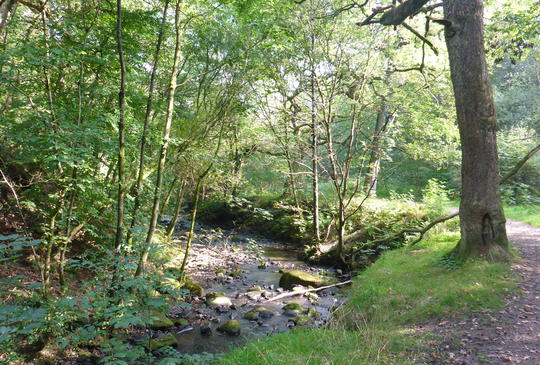
Greening Bolton
Two, a new country park and one of the UK’s biggest solar farms, are clustered around Junction 4 of the M61, while a third will see the moorlands of the Smithills Estate, overlooking the town, returned to their former glory.
The new solar farm has been built in just six months on land owned by the Greater Manchester Waste Disposal Authority (GMWDA) and features 8,400 solar panels. In a classic ‘renewables analogy’, that’s enough to power around 600 homes for a year, but in this instance the 2,200 MWh a year produced by the array will be used to power GMWDA’s own in-Vessel Composter (IVC).
The IVC is designed to treat around 50,000 tonnes of garden and kitchen waste a year, turning it into compost. Using the solar power will save over 600 tonnes CO2 annually, with any surplus power fed back into the National Grid.
The farm takes up around four hectares in the centre of the authority’s Salford Road site. The previously unused land sits between a recycling centre and loading station, and GMWDA were unsure how best to use it explains Mark Newall, the authority’s Director of Resources and Strategy.
“We wanted an environmental solution that fitted in with our sustainability plans and we came up with the idea of a solar farm as the best use for the site,” he says, adding that it also met with the resounding approval of local residents.
“Importantly, it also fits in with the wider GM Climate Change Action Plan and helps contribute to the 48% carbon reduction target.”
The authority run 42 sites across the region, says Newall, and although none have the space for a similar solar farm, putting PV panels on the roofs of all their other buildings is something they are considering for the future.
Next door to the wind farm, the Logistics North site at Cutacre is beginning to take shape. Alongside major distribution centres for the likes of Aldi, and defence manufacturer MBDA, the site will also feature a new, 266 hectare country park, an important green lung for the people of Bolton, and for the 7000 people who could ultimately be employed on the site.
The land was a former surface mine, explains Iain Thomson, communications and partnership manager at the site’s owners, Haworth Estates. And although used by dog walkers, joggers and the odd cyclists, the site lacked any real structure, let alone plans to enhance its biodiversity.
“Local people were insistent that unless they had a country park, the distribution centre wouldn’t have been built.
“We’ve now planted 40,000 trees to really kick start the country park, so that people can see the progress that’s being made,” says Iain, with the majority native species such as field maple, birch, alder, aspen and wild cherry.
While it could take up to ten years before Logistic North is finished, the country park is already open and will continue to be developed over the next few years. Plans include remodelling some of the landscaping to include extra lakes and ponds, while existing rights of way across the park will be developed, with a new network of cycle and bridleways, as well as pockets of woodland and viewing points.
The final part in Bolton’s green jigsaw is the work being carried out by the Woodland Trust on the Smithills Estate.
Described as a ’quiet wilderness’ on Bolton’s doorstep, the 690 hectare site is the largest owned by the Trust in England. It is also represents a new departure for the charity, says Smithills project manager Mark Gordon.
In the past, he explains, the Trust has looked to either protect pockets of ancient trees, or plant new woodlands.
“This is different,” he says. “It’s a landscape where we want to improve tree cover but it’s not about planting a new forest. It’s about protecting a diverse landscape of heath, moor and bog. It’s a new string to our bow - we want to make the landscape more resilient.”
Mark concedes that in the past the Trust hasn’t done enough to address the needs of upland areas, despite the fact they make up around 40% of the UK landscape.
Smithills was once a rich mosaic of grassland, moorland and bog habitats but centuries of exploitation, including quarrying, mining and draining water to supply local industries, had left a landscape on the edge.
"A once precious upland ecosystem has been neglected, overgrazed and mismanaged, reducing its biodiversity and leaving wildlife vulnerable," says Gordon.
There’s a long history of public access to Smithills, too. In 1896, more than 30 years before the famous Kinder Scout mass trespass, 10,000 people took to the moors, demanding their right to access a place which was at risk of being closed off for grouse shooting.
Now, as well as doubling tree cover to around 20%, paths will be improved and extended, and new interpretation boards erected to explain the history of the landscape.
There are also plans to work with social enterprises, encouraging them to use the site in a sustainable way and encourage local employment and investment.
“The other great thing about Smithills is that it also addresses another of our objectives, engagement,” adds Mark. “Because so many people live close to Smithills they’ll hear about the Trust, see what we’re doing and be able to get out and enjoy the moors for themselves.”
You can watch a short film about Smithills by clicking here.
Contributor Profile
Mark Hillsdon is a freelance writer with a passion for nature and the great outdoors. A regular contributor to magazines such as Coast and CountryFile, he also writes on sustainability for the Guardian, and the occasional travel piece for the Independent. On Sunday. He has also been writing on all things Mancunian since first getting off the Euston train as a student nearly 30 years ago.





